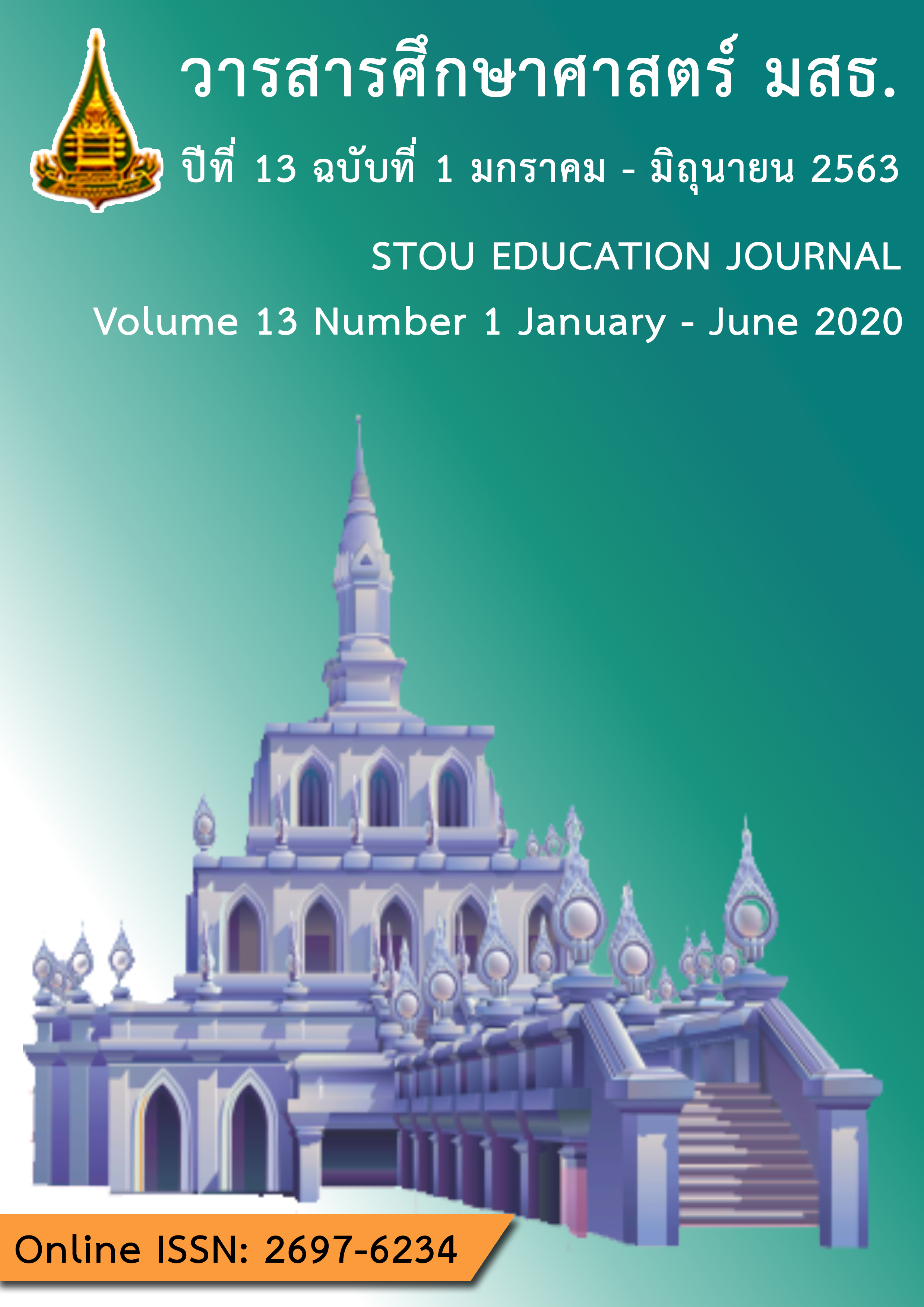Development of Massive Open Online Course (MOOC) Instructional Model Based on Collaborative Learning for Learners with Different Learning Styles
Main Article Content
Abstract
This research aims to 1) develop Massive Open Online Course (MOOC) instructional model; 2) create a lesson on MOOC; and 3) study the results of using MOOC instructional model. The population comprised 306 students registered and conducted educational activities in the Basic Infographic course offered on the Thai MOOC website (www.thaimooc.org) for six weeks. The research instruments were 1) lessons on MOOC, 2) a learning achievement test, and 3) an evaluation form to assess the satisfaction of learner with MOOC instructional model. Data were analyzed using the percentage, mean, and standard deviation. The research findings show that 1) MOOC instructional model consists of three main components which are: (a) input factors which consist of six issues, namely, learner’s learning-style analysis, content analysis, instructional activity design, MOOC design, learning resources, and learning tool analysis, (b) the process which consists of three main steps, namely, preparing, teaching, and review and testing, and (c) outputs which consist of three issues, namely, learning achievement, participation in learning activities, and satisfaction; the quality of MOOC instructional model was at the highest level (M = 4.57); 2) the quality of MOOC was at the highest level
(M = 4.63) with efficiency of 77.00/76.33; and 3) regarding the results of using MOOC instructional model, it is found that (a) on learning achievement, the learners have the mean score of 35.82; (b) on participation in learning activities, the learners have the mean score of 41.47, with the learners in the creative thinking analysis group having the highest mean score of 42.13; also, the learners are satisfied with MOOC instructional system at the high level, with the satisfaction rating mean of 4.45.
Article Details
References
จินตวีร์ คล้ายสังข์. (2556). MOOCs PEDAGOGY: จาก OCW, OER สู่ MOOCs เครื่องมือเพื่อการเรียนรู้สำหรับผู้เรียนยุคดิจิทัล. การประชุมวิชาการระดับชาติด้านอีเลิร์นนิง ประจำปี 2556. กรุงเทพมหานคร: ThaiCyberU.
ใจทิพย์ ณ สงขลา. (2550). E-Instructional Design วิธีวิทยาการออกแบบการเรียนการสอนอิเล็กทรอนิกส์. กรุงเทพมหานคร: ศูนย์ตำราและเอกสารทางวิชาการ คณะครุศาสตร์ จุฬาลงกรณ์มหาวิทยาลัย.
ฉลอง ทับศรี. (2549). การออกแบบระบบการเรียนการสอน (Instructional Design). เอกสารการสอนวิชาการออกแบบการเรียนการสอน (423511). ชลบุรี: ภาควิชาเทคโนโลยีทางการศึกษา คณะศึกษาศาสตร์ มหาวิทยาลัยบูรพา.
ชัยยงค์ พรหมวงศ์. (2556). การทดสอบประสิทธิภาพสื่อหรือชุดการสอน.วารสารศิลปากรศึกษาศาสตร์วิจัย, 5(1). 5-20. สืบค้นจาก http://www.kmutt.ac.th/jif/public_html/article_detail.php?ArticleID=130421
ทิศนา แขมมณี. (2553). ศาสตร์การสอน: องค์ความรู้เพื่อการจัดกระบวนการเรียนรู้ที่มีประสิทธิภาพ (พิมพ์ครั้งที่ 12). กรุงเทพมหานคร: สำนักพิมพ์แห่งจุฬาลงกรณ์มหาวิทยาลัย.
ปราวีณยา สุวรรณณัฐโชติ และเสมอกาญจน์ โสภณหิรัญรักษ์. (2560). มาตรฐานและแนวปฏิบัติการเรียนการสอน MOOC ที่ได้รับการยอมรับในระดับนานาชาติ. กรุงเทพมหานคร: โครงการมหาวิทยาลัยไซเบอร์ไทย สำนักงานคณะกรรมการการอุดมศึกษา.
ปิยะฉัตร จิตต์ธรรม. (2557). เอกสารประกอบการอบรมเชิงปฏิบัติการ “ความสร้างสรรค์และนวัตกรรมทางการศึกษา”. สถาบันนวัตกรรมการเรียนรู้ มหาวิทยาลัยมหิดล.
พิมพ์พันธ์ เดชะคุปต์ และพเยาว์ ยินดีสุข. (2557). การจัดการเรียนรู้ในศตวรรษที่ 21. กรุงเทพมหานคร: โรงพิมพ์แห่งจุฬาลงกรณ์มหาวิทยาลัย.
วรรณพงษ์ เตรียมโพธิ์ และอาทร นกแก้ว. (2557). เอกสารประกอบการอบรมเชิงปฏิบัติการ “ผู้เรียน Gen Z เรียนรู้ได้อย่างไร”. สถาบันนวัตกรรมการเรียนรู้ มหาวิทยาลัยมหิดล.
วิจารณ์ พานิช. (2555). วิถีสร้างการเรียนรู้เพื่อศิษย์ ในศตวรรษที่ 21. กรุงเทพมหานคร: ตถาตา พับลิเคชั่น จำกัด
อาภรณ์ ใจเที่ยง. (2553). หลักการสอน (พิมพ์ครั้งที่ 5). กรุงเทพมหานคร: โอเดียนสโตร์.
เอมอร กฤษณะรังสรรค์. (2558, สิงหาคม 1). รูปแบบการคิด (Cognitive Style) และรูปแบบการเรียนรู้ (Learning Style). สืบค้นจาก http://www.novabizz.com/NovaAce/Learning/Cognitive_Style.htm
Altowairiki, N. F. H. (2013). Instructors' and students' experiences with online collaborative learning in higher education. (Master thesis ). Retrieved from https://prism.ucalgary.ca/handle/11023/850
Barkley, E. F., Major, C. H., & Cross, P. (2014). Collaborative learning techniques: A handbook for college faculty (2nd ed.). San Francisco: Jossey-Bass, A Wiley Brand.
Claffey, G. F., Jr. (2015). MOOC Learning and impact on public higher education (Doctoral dissertation). Retrieved from https://search-proquest-com.unco.idm.oclc.org/docview/1728802935?pq-origsite=summon
Culatta, R. (2013). ADDIE Model. Retrieved from http://www.instructionaldesign.org/models/addie.html
Globalvision. (2013, September 23). Trend Watch: Massive Open Online Courses. Retrieved from http://www.globalvision.com.au/archives/1152
Grunewald, F., Meinel, C., Totschnig, M., & Willems, C. (2013). Designing MOOCs for the support of multiple learning styles. In Hernádez-Leo, D., Ley, T., Klamma, R., & Harrer, A. (2013). Scaling up learning for sustained impact: 8th European conference, on technology enhanced learning, EC-TEL 2013
Gulatee, Y., & Nilsook, P. (2014). Elements of learning design for MOOCs. Retrieved from https://www.academia.edu/19520807/Elements_of_Learning_Design_for_MOOCs?email_work_card=view-paper.
Kop, R. (2011). The challenges to connectivist learning on open online networks: Learning experiences during a massive open online course. The International Review of Research in Open and Distributed Learning, 12(3), 19-38. doi:10.19173/irrodl.v12i3.882
Langrehr, J. (2005). Assessing creative & critical thingking, Victoria: Hawker Brownlow Education.
Li, K. (2015). Motivating learners in massive open online courses: A design-based research approach (Doctoral dissertation). Retrieved from https://eric.ed.gov/?id=ED567912
Murray, S. (2013). “What is the Media & Cultural Studies of the MOOC?” response media and culture. Retrieved from http://blog.commarts.wisc.edu/2013/03/11/MOOC/
Spector, J. M. (2014). Remarks on MOOCS and mini-MOOCS. Educational Technology Research and Development, 62(3), 385-392. doi:10.1007/s11423-014-9339-4
Stanley, L. E. (2015). A qualitative study of instructional design in massive open online courses (MOOCs) (Doctoral dissertation). Retrieved from https://search.proquest.com/openview/e92752606178e5a1a3583095889f5148/1?pq-origsite=gscholar&cbl=18750&diss=y
Wang, C., Shannon, D. M., & Ross, M. E. (2013). Students' characteristics, self-regulated learning, technology self-efficacy, and course outcomes in online learning. Distance Education, 34(3), 302-323. doi:10.1080/01587919.2013.835779
Wong, J., Baars, M., Davis, D., Van Der Zee, T., Houben, G., & Paas, F. (2019). Supporting self-regulated learning in online learning environments and MOOCs: A systematic review. International Journal of Human-Computer Interaction, 35(4-5), 356-373. doi:10.1080/10447318.2018.1543084


